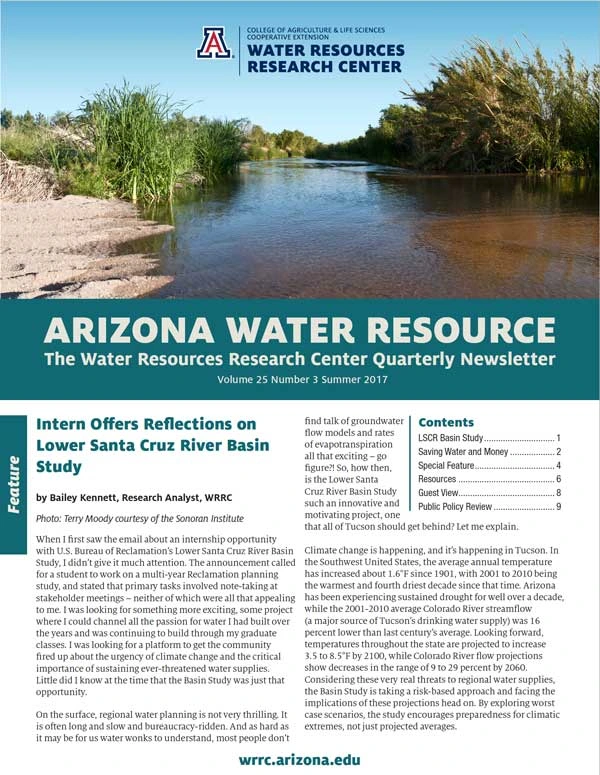
Student perspectives are featured in this issue of Arizona Water Resource, with articles on the Lower Santa Cruz River Basin Study and the potential economic benefits of water conservation, which convey their passion and commitment to addressing water resource issues. Another perspective is presented in the Guest View by the Executive Director of the Yuma Center of Excellence for Desert Agriculture, who looks at the feasibility and advisability various methods of agricultural water conservation. A Special Feature reports on two recently completed research projects that tackle very different questions about water reuse. A Resources section highlights two new water books, and WRRC Director Sharon B. Megdal’s Public Policy Review column describes how the cooperative framework that shapes the U.S.-Mexico Transboundary Aquifer Assessment Program is a model for other transboundary efforts around the globe.
Intern Offers Reflections on Lower Santa Cruz River Basin Study
When I first saw the email about an internship opportunity with U.S. Bureau of Reclamation’s Lower Santa Cruz River Basin Study, I didn’t give it much attention.
Saving Water Can Put Money in The Bank!
Conserving water and using it efficiently. Can there really be money in that? Communities are often motivated to conserve water for hydrological and environmental benefits such as groundwater recharge or environmental restoration, including reintroduction of animal populations, yet the economic benefits of water conservation and improvements in water use efficiency can be a potent motivator.
Special Feature: Research Projects Focus on Water Reuse
Two water quality research projects, funded through the Water Resources Research Center, reported their results in May. The WRRC receives funding from annual appropriations to the U.S. Geological Survey to support the national Water Resources Research Institutes program.
Guest View: Shouldn’t Ag Water Conservation Be Used For.....Agriculture?
Water is a hot topic in the desert southwest, and agriculture uses a lot of it. Are there ways for agriculture to save water? If so, what should it be used for, and how would agriculture and rural communities be impacted?
Public Policy Review: The Cooperative Framework for the Transboundary Aquifer Assessment Program
Being part of the team working on the Transboundary Aquifer Assessment Program (TAAP) continues to be gratifying. The International Boundary and Water Commission’s (IBWC) recent publication of the Binational Study of the Transboundary San Pedro Aquifer (San Pedro Study) marked a milestone.
Resources
- Water Governance, Stakeholder Engagement, and Sustainable Water Resources Management
- Price of Water 2017: Four Percent Increase in 30 Large U.S. Cities
- High And Dry: Meeting the Challenges of the World’s Growing Dependence on Groundwater
- Energy-Water Policy Database
- Perspectives on America’s Water
- 1981-2010 Climate Normals – Climographs
- Device Helps Save Shower Water

